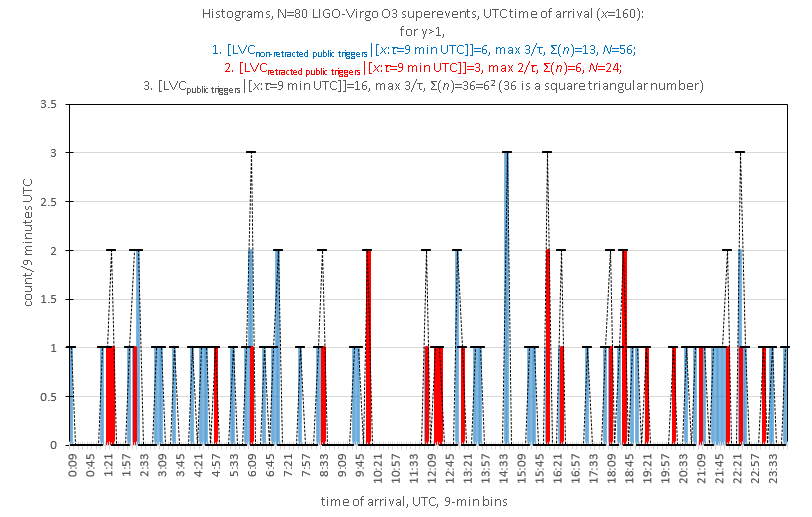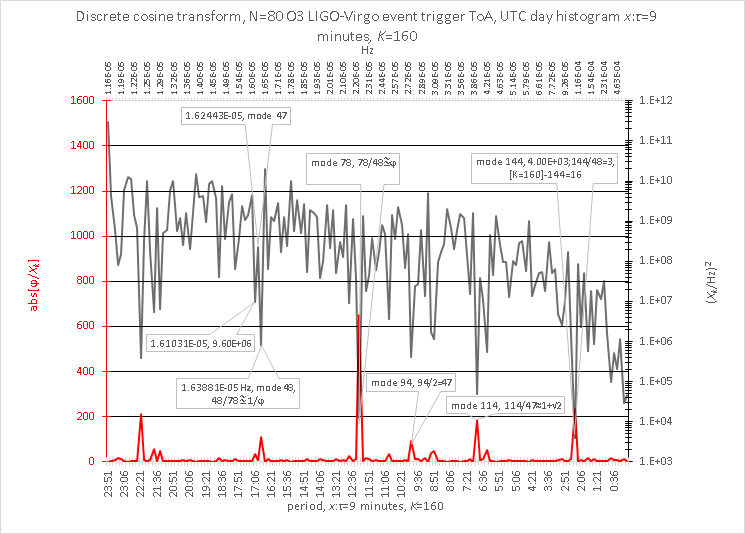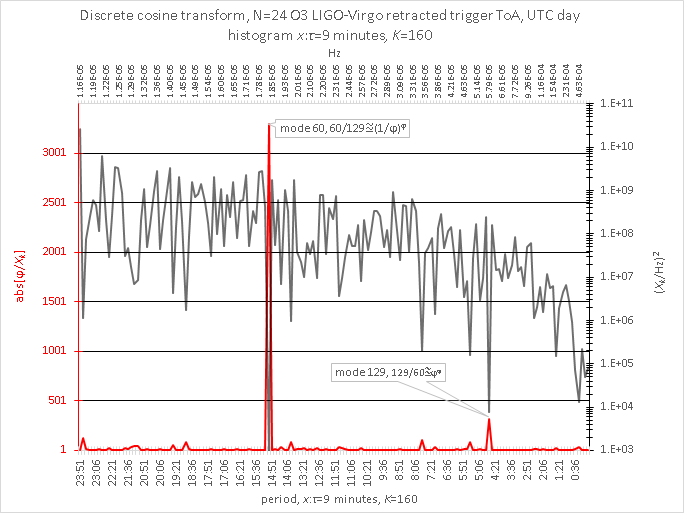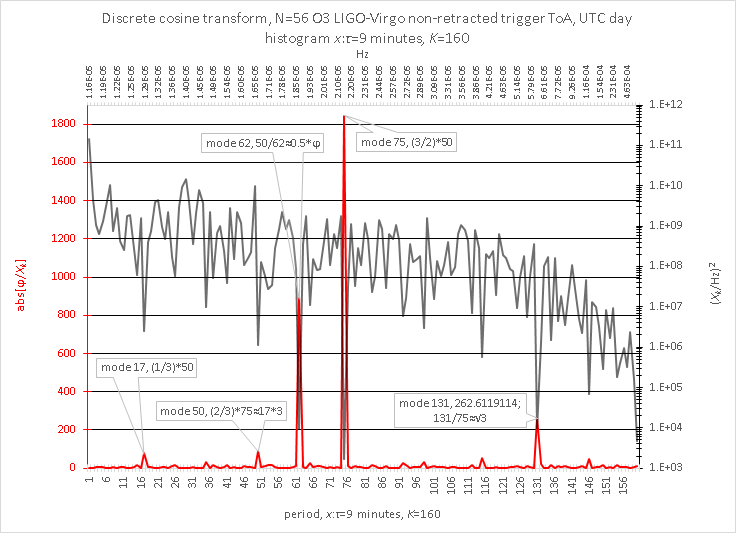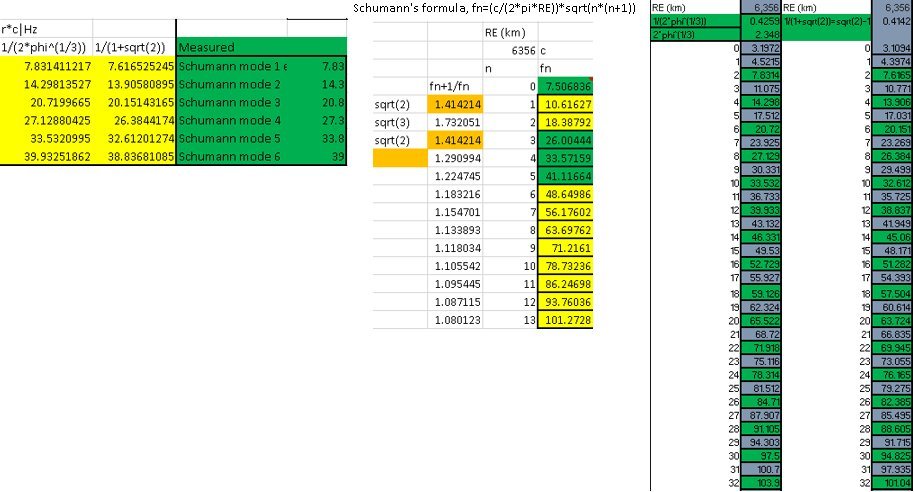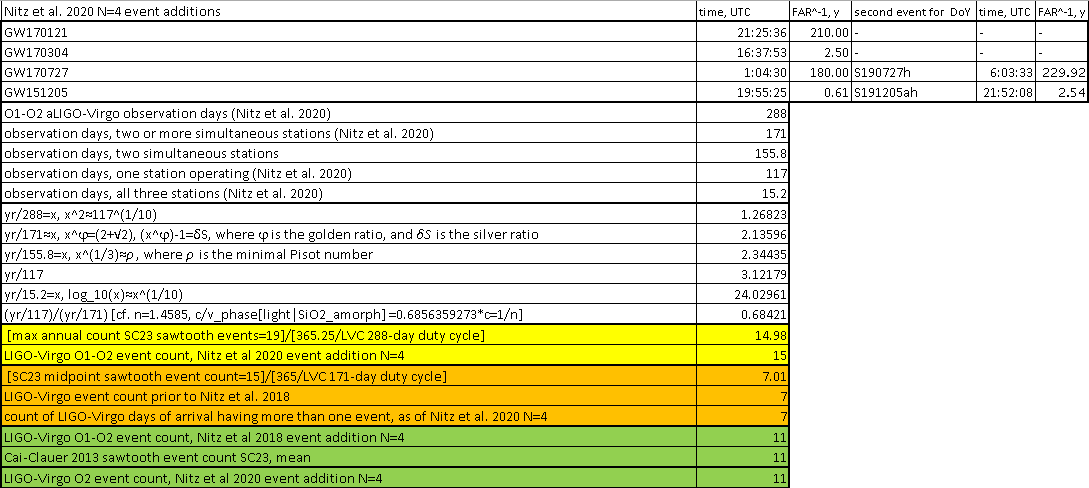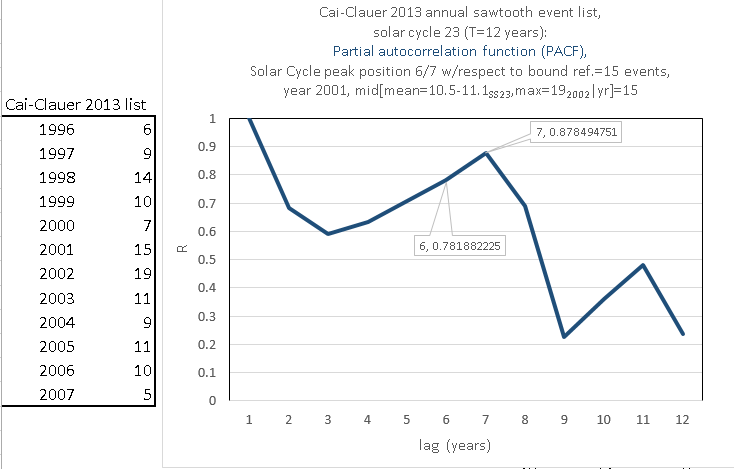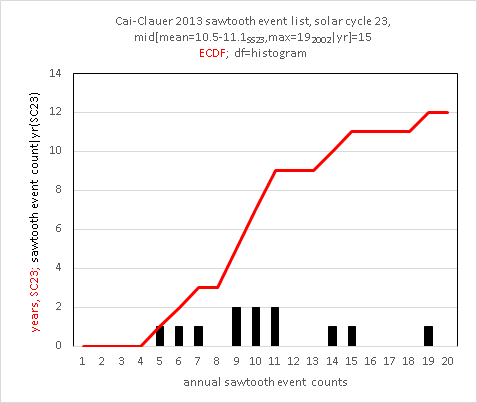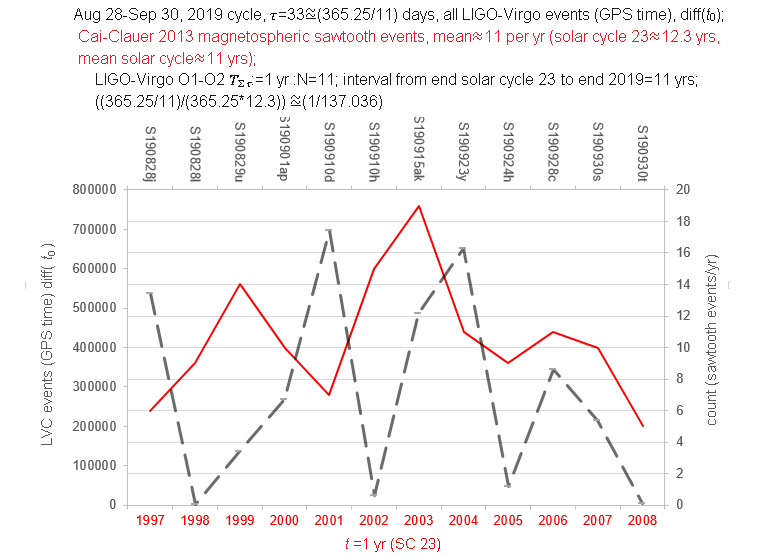UPDATE
two new responses to Nielsen et al. 2018 became available Spring 2019:
1. [Jackson et al. 2019] Noise residuals for GW150914 using maximum likelihood and numerical relativity templates
2. [Maroju et al. 2019] Looking for ancillary signals around GW150914
Both papers find that results of attempted refutations of residual correlations around GW150914 (e.g. Nielsen et al. 2018 and Green-Moffat 2017/8) are intrinsically spurious, in that complex lag correlations do in fact persist despite use of improper ML templates with uncorrelated synthetic/sampled noise to simulate robustness. Nielsen et al. 2018 is especially inconsistent and problematic given the circular logic necessary to rationalize the incompatibility of the decorrelated best fit template with the models from which "confident" source parameters were calculated by LVC. The conclusions of Jackson et al. 2019 and Maroju et al. 2019 are supported throughout the blog author's prior and parallel multiscaled analyses [ LIGO-Virgo signals are generated by strong compound coupling/decoupling within a scale-invariant, nonstationary, degenerate, and persistent propagating rarefacted ground state supporting instanton-soliton transient production transverse to time domain, identical to expected circular cavity artifacts]. My prompt critical response as Nielsen et al. 2018 became available on arXiv follows, finding the same methodological biases and blunders found by Jackson et al. 2019, while Maroju et al. 2019 supports the presence of extended lag correlations for tens of minutes around trigger, supporting prior criticism of GW150914 signal extraction/interpretation in Creswell et al 2017 and elsewhere]
[2018-12-11] LIGO-Virgo collaboration continues to deny foreground contamination while publicly-devaluing purpose for meta-analysis of LVC statistical error, and such choices are continuing to plague LIGO phenomenological consistency, eroding confidence in extended cosmological application of LIGO findings; instead, by appealing to a series of improper reanalyses presented against Creswell et al. 2017, public obligation for LIGO response to an outspoken critic was restricted onto a piecemeal series of incommensurate tests for empirical cross-correlations by using synthetic data, deliberately avoiding exact replication in so many words. The deceptive incongruity of LIGO reanalyses with respect to Creswell et al 2017 is a troubling index of a more disturbing trend. Wording plays too important a role in the presentation of LIGO reanalyses in this context. That these publications are brandished as apotropaia (without acknowledgment of their fundamental deviations from proper methodological replication), and that their conclusions are as such not being understood or adequately explained, demands reassessment of LIGO as a social institution as well as a simplistically-tenebrous research effort.
Below, I venture toward critiques of three very recent papers (2nd half of 2018) published and/or strongly promoted by LIGO and collaboration as New Scientist (Oct. 31 2018) rekindles a debate that had not merely evaporated otherwise, but first we revisit Ian Harry's sophomoric phase space analysis. These short notes are followed by a supplementary section introducing foreground noise sources and reports detailing LIGO instrumental response with respect to the current state of signal/noise discrimination protocols; sections are enumerated. The first two papers examined are Nielsen et al 2018 ([1811.04071] Investigating the noise residuals around the gravitational wave event GW150914) and Green and Moffat 2018 ([1711.00347] Extraction of black hole coalescence waveforms from noisy data), followed by van Putten et al. 2018 ([1806.02165] Observational evidence for Extended Emission to GW170817). As not all problems inherent with LIGO-Virgo science are exclusive to the confirmation and classification of GW150914, we must include interpretive inconsistencies with GW data and BH population scaling. Excessive correlation between LIGO event parameter/source property error and arrival time, driven noise floor phase coherence and coincident geophysical/space physical events during all seven LIGO-Virgo events compounds apparent GW170817/GRB170817A/NGC 4993/AT 2017gfo incompatibility and multiple comparisons expressed uniquely by several equally-credible research collaborations.
Ongoing multi-disciplinary work with LIGO data is summarized and presented with an open data protocol on this blog, beginning with GW150914: orphans of abductivism and extending into GW170817 orphans of abductivism and beyond orphans of abductivism.
Cosmologist Peter Coles presents his own highly-informed feedback, on his blog, to both late-2018 New Scientist articles and consequential LIGO and NBI statements, in the wake of this renewed controversy, regularly expressing his discomfort with LIGO opposition to an analytical-quality open science protocol. He has been present at colloquia between NBI and LIGO, and his blog has been a valuable resource throughout ongoing NBI/LIGO debate. He was quoted in the Oct. 31, 2018 New Scientist article https://www.newscientist.com/article/mg24032022-600-exclusive-grave-doubts-over-ligos-discovery-of-gravitational-waves/, who reassures the reader as to the credibility of the NBI collaboration.
https://telescoper.wordpress.com/2018/11/01/grave-wave-doubts/
https://telescoper.wordpress.com...
LIGO and Open Science
Questioning LIGO
One should consider that the NBI collaboration's work with LIGO data is not limited to a single peer-reviewed paper, and that several papers involving signal processing with LIGO data, dating from 2016–2018 are available on the website of the NBI collaboration: http://www.nbi.ku.dk/gravitational-waves/gravitational-waves.html
I. It should also be noted that conclusions asserted through attempts at synthetic reproduction of trivialized systematic residual phase correlations from the oft-cited guest post by Ian Harry on Sean Carroll’s popular blog have not been valid since July, 2017 at the very latest, yet no retractions have been made. This is outrageously-unethical, as a non-retraction crisis plagues many fields, yet physicists and astronomers seem to be exempt from the responsibility of apprising the public of epistemic error. GW Comments 2
Ian Harry’s code error (consisting of several coding errors throughout the workbook) undermines any validity to analysis or phenomenological/methodological arguments on Sean Carroll’s blog [A Response to “On the time lags of the LIGO signals” (Guest Post)]. It had been gingerly acknowledged by the LIGO collaboration only after the Danish collaboration pointed it out to LIGO [Gravitational waves], but Ian Harry’s guest post was not retracted or corrected, who had promised by July, 2017 to publish an appropriate journal-length refutation of the Creswell et al. 2017 findings. The corrected LIGO workbook also fails to refute the correlations claimed by Creswell et al. 2017 [1706.04191] On the time lags of the LIGO signals and extended to show further events are roughly identical to driven non-Gaussian noise by A. Raman [1711.07421] On the Signal Processing Operations in LIGO signals to such a serious extent that bogus FM templates cross-correlated with non-signal LIGO noise around events triggers LIGO CCF searches, regardless of amplitude.
Green and Moffat 2018 (v1 2017) and Nielsen et al. 2018 implicitly-acknowledge Ian Harry’s code errors, which were identified swiftly by the NBI team. Duncan Brown, a co-author of Nielsen et al. 2018, was present at discussions between LIGO team members and NBI critics. Window functions are no longer being considered responsible for excess phase correlations as identified in Creswell et al. 2017 and elsewhere.
______________________________________________________________________________
II. A strategically-timed paper submitted to the arXiv November, 2018 (Nielsen et al. 2018 ([1811.04071] Investigating the noise residuals around the gravitational wave event GW150914) was scheduled to superficially-quell recent renewed alarm raised by NS and the NBI group. It contains terminological and representational errors that affect transparency, was not peer-reviewed, and has been heavily promoted by the LIGO collaboration, Alexander Nitz and Christopher Berry on Twitter within the first week of its submission (which I had the pleasure of confronting in real time, pointing out multiple methodological errors and circuitous lapses of transparency directly to Alexander Nitz). The paper, in fact, is yet another incommensurate and incomplete reanalysis of lag correlations between template-signal residuals and template-synthetic colored noise residuals. All four listed authors (including Duncan Brown), according to Chris Berry on twitter, have left the LIGO collaboration (he apprised me of this without much hesitation in order to distance himself from responsibility in the name of the LIGO collaboration for problems I was pointing out). Is it that their paper is so transparently a dilatory strategy, or is it that well-known LIGO authors truly care about mathematical rigor and logical consistency that has compelled the authors of yet another improper falsification of Creswell et al. 2017 to have departed the prestigious LIGO-Virgo consortium? Duncan Brown, a computational astrophysicist, is still apparently giving talks on GW, but to what degree the content of his lectures of personal work now depends on analysis of LIGO GW event data is unknown to me.
It must be strongly emphasized that no analysis of L1|H1 direct CCF for the entire 40 minute correlation period claimed in Creswell et al. 2017 was performed in Nielsen et al. 2018, and so there isn't any actual replication of the total critical domain of Creswell et al 2017, let alone any attempt to satisfy demands of rigorous argument given the degree of data manipulation and unwarranted introduction of a new template as employed by Nielsen et al. A single family of arguments is superficially exhausted, distracting us from the more insidious trend in LIGO-Virgo ignorance of their own systematic error.
Using Pearson coefficients of modeled colored Gaussian noise instead of those from paired real noise samples neglects that noise and signal in real h(t) strain are argued to be coherent and indivisible; an ML template optimized to select strongest GW frequency components is chosen to minimize phase correlations, but synthetic Gaussian noise is colored with amplitude information. Modeled noise is therefore fundamentally-incomparable to phase of signal, if we admit the necessity for rejecting the null hypothesis that noise and signal phase are not independent. Subharmonic distributions from colored Gaussian noise will not correlate with real noise, and this is also required to test the fitness of samples. Synthetic noise is processed incorrectly without attention to the ASD of near-event strain noise. The windowed time series amplitude peak (inspiral phase) residuals should be cross-correlated continuously with the remainder of the extended (>0.2 s) strain signal, as mode clarity for partition-sensitive quasiperiodic phase evolution is time-dependent. [Non-Gaussian] dual-detector h(t) data, transformed into Pearson cross-correlations, cannot be intrinsically-compared with whitened h(t) data or colored Gaussian noise, as h(t) data are phase encoded at a finite sampling rate, with residual correlations broken due to performance of an improper amplitude-biased template subtraction (NR, ML template) on Gaussian (inherently uncorrelated) test data.
By far, this is the most serious methodological mistake in Nielsen et al. 2018. Subtle H1 phase shift, or H1 ML template time reversal symmetry deviation displaces, fractionally-distributes, and inverts cross-correlations and preserves multiple partial correlations. Prior ACF classification, not merely cross-correlation of standardized data, is crucial.
Anticorrelation in the semi-empirical curves is inverted at the same interval with joint correlation at -7 and 7 ms in the synthetic data. The [Bayesian] maximum likelihood (ML)-subtracted curves do not show lag interval fits, but do not fit primary, analytical LIGO NR template, which means the paper does not succeed in producing a convincing falsification of Creswell et al. 2017. Noise was not modeled directly upon signal unique to each detector, as the claim goes. As there are still multiple correlations at significant ratios in the results of Nielsen et al. 2018, manipulation of output of the replication analysis shows Gaussian partitioning was selected to preferentially EXCLUDE +/- 7 ms in two-sided cross-correlations. To retain independence from systematic error, ML template must show the same partial autocorrelation partitions as the NR template; the ACF of the ML template doesn't fit the official LIGO NR template used to calculate source parameters found in what I assume all LIGO collaboration publications. The ML data also show partial correlation with the real/NR data with the same positive correlations at -7 ms and 7 ms.
Actual shifted cross-correlations in Creswell et al. are technically anticorrelations, and signal lags are inverted and symmetric around 0. The shifting of a priori lagged data with periodic phase correlations produces an anticorrelated positive time lag; synthetic noise generated from real GW signal modes that may be dispersive, encoding nonstationary terrestrial Doppler information (GW150914-H1 shows less degeneracy, lower Q-factor, and flatter power distribution - with greatest density <140 Hz – than GW150914-L1; this, and the mostly negative ASD phase spectrum). Band-specific and phase-specific spectral artifacts can be conflated with NR template, given incomplete notching and simple shifting-inversion of lagged LIGO strain signal assumed to be dispersionless, but polarized.
Considering that respective LIGO detector strain may not be bijective due to time-dependency, correlations between noise and signal residuals did not simply go away provided the simplistic way the data are treated. Relative nonstationarity in H1|L1 data can be found by considering negative lag symmetry of cross-correlated ML-subtracted data, with the signal of the NR-subtracted shifted data – strongly-negative cross-correlation (anticorrelation) at +7 ms – showing the propagated mismatch effect between NR templates utilized to subtract GW150914 and estimate source properties. -7 ms positive cross-correlation between ML-subtracted data preserves lower significance +7 ms positive cross-correlation, but without NR template-subtracted negative cross-correlation found in Creswell et al. 2017. This recalcitrant displacement reveals the non-triviality and intrinsicity of time reversal-asymmetry. Transverse strain density and envelope are correlated, and the mere inversion and shifting of lagged detector data cannot conceal time dependency, nor can the ASD phase spectrum of lagged strain, such as GW150914-L1, which is dominated by negative power, while L1 is dominated by positive phase. Another possibility arises: the emitter is located horizontally in mutual line-of-sight of LIGO. Shifting 0.007s cannot correctively-weight the evolution of H1 in phase space; the wavelength of a 0.0069-0.0072s signal (139-145 Hz) at v=c is identical to the propagation distance between H1 and noise source. If noise prior to and following transient arrival contains a strong lag locked with GW150914, the CSD of unshifted L1|H1 noise will show enhanced power with discrete features at 138-145 Hz.
(see 1. orphans of abductivism, 2. orphans of abductivism, 3. orphans of abductivism, 4. orphans of abductivism, 5. orphans of abductivism)
By treating the data as dispersive, one can remove insignificant periodic phase correlations and other evidence of nonlinear monotonic cross-talk (systematic error) sensitive to sample window size, given that all calibration lines are properly notched. Conversely, using both versions or both sampling resolutions of public LIGO strain data sets together, with the 1 ms shifted difference in v1, would effectively split, invert, and fractionalize cross-correlations, similar to the results obtained in Nielsen et al. 2018. If posterior ML analysis treats lag-corrected NR|signal as time independent, asymmetry and phase mismatch relegated to spin, polarization, redshift, Doppler effect, and binary source dynamical ellipticity and tidal potentials from quasinormal envelopes in LIGO-Virgo strain may, in effect, be spurious - the systematic effect of dispersive broadband propagation of superposed caustic-like horizons observed non-orthogonally, with elliptical TM polarization. Relativistic, radial, annular EM wavefront collisions are common in thunderstorms (in ELVES and sprites), as are ducted gamma glows: Lightning produces afterglow of gamma radiation (Lightning produces afterglow of gamma radiation)
The v2 LIGO strain data were not available at the time the original NBI findings were presented. V1 is assumed to be crucial to original parameter estimation and signal isolation of GW150914. A proprietary LIGO process is not explicated to show differences between v1 and v2 other than a 1 ms shift in the 4096 Hz data.
Cosmologist Peter Coles presents his own highly-informed feedback, on his blog, to both late-2018 New Scientist articles and consequential LIGO and NBI statements, in the wake of this renewed controversy, regularly expressing his discomfort with LIGO opposition to an analytical-quality open science protocol. He has been present at colloquia between NBI and LIGO, and his blog has been a valuable resource throughout ongoing NBI/LIGO debate. He was quoted in the Oct. 31, 2018 New Scientist article https://www.newscientist.com/article/mg24032022-600-exclusive-grave-doubts-over-ligos-discovery-of-gravitational-waves/, who reassures the reader as to the credibility of the NBI collaboration.
https://telescoper.wordpress.com/2018/11/01/grave-wave-doubts/
https://telescoper.wordpress.com...
LIGO and Open Science
Questioning LIGO
One should consider that the NBI collaboration's work with LIGO data is not limited to a single peer-reviewed paper, and that several papers involving signal processing with LIGO data, dating from 2016–2018 are available on the website of the NBI collaboration: http://www.nbi.ku.dk/gravitational-waves/gravitational-waves.html
I. It should also be noted that conclusions asserted through attempts at synthetic reproduction of trivialized systematic residual phase correlations from the oft-cited guest post by Ian Harry on Sean Carroll’s popular blog have not been valid since July, 2017 at the very latest, yet no retractions have been made. This is outrageously-unethical, as a non-retraction crisis plagues many fields, yet physicists and astronomers seem to be exempt from the responsibility of apprising the public of epistemic error. GW Comments 2
Ian Harry’s code error (consisting of several coding errors throughout the workbook) undermines any validity to analysis or phenomenological/methodological arguments on Sean Carroll’s blog [A Response to “On the time lags of the LIGO signals” (Guest Post)]. It had been gingerly acknowledged by the LIGO collaboration only after the Danish collaboration pointed it out to LIGO [Gravitational waves], but Ian Harry’s guest post was not retracted or corrected, who had promised by July, 2017 to publish an appropriate journal-length refutation of the Creswell et al. 2017 findings. The corrected LIGO workbook also fails to refute the correlations claimed by Creswell et al. 2017 [1706.04191] On the time lags of the LIGO signals and extended to show further events are roughly identical to driven non-Gaussian noise by A. Raman [1711.07421] On the Signal Processing Operations in LIGO signals to such a serious extent that bogus FM templates cross-correlated with non-signal LIGO noise around events triggers LIGO CCF searches, regardless of amplitude.
Green and Moffat 2018 (v1 2017) and Nielsen et al. 2018 implicitly-acknowledge Ian Harry’s code errors, which were identified swiftly by the NBI team. Duncan Brown, a co-author of Nielsen et al. 2018, was present at discussions between LIGO team members and NBI critics. Window functions are no longer being considered responsible for excess phase correlations as identified in Creswell et al. 2017 and elsewhere.
______________________________________________________________________________
II. A strategically-timed paper submitted to the arXiv November, 2018 (Nielsen et al. 2018 ([1811.04071] Investigating the noise residuals around the gravitational wave event GW150914) was scheduled to superficially-quell recent renewed alarm raised by NS and the NBI group. It contains terminological and representational errors that affect transparency, was not peer-reviewed, and has been heavily promoted by the LIGO collaboration, Alexander Nitz and Christopher Berry on Twitter within the first week of its submission (which I had the pleasure of confronting in real time, pointing out multiple methodological errors and circuitous lapses of transparency directly to Alexander Nitz). The paper, in fact, is yet another incommensurate and incomplete reanalysis of lag correlations between template-signal residuals and template-synthetic colored noise residuals. All four listed authors (including Duncan Brown), according to Chris Berry on twitter, have left the LIGO collaboration (he apprised me of this without much hesitation in order to distance himself from responsibility in the name of the LIGO collaboration for problems I was pointing out). Is it that their paper is so transparently a dilatory strategy, or is it that well-known LIGO authors truly care about mathematical rigor and logical consistency that has compelled the authors of yet another improper falsification of Creswell et al. 2017 to have departed the prestigious LIGO-Virgo consortium? Duncan Brown, a computational astrophysicist, is still apparently giving talks on GW, but to what degree the content of his lectures of personal work now depends on analysis of LIGO GW event data is unknown to me.
It must be strongly emphasized that no analysis of L1|H1 direct CCF for the entire 40 minute correlation period claimed in Creswell et al. 2017 was performed in Nielsen et al. 2018, and so there isn't any actual replication of the total critical domain of Creswell et al 2017, let alone any attempt to satisfy demands of rigorous argument given the degree of data manipulation and unwarranted introduction of a new template as employed by Nielsen et al. A single family of arguments is superficially exhausted, distracting us from the more insidious trend in LIGO-Virgo ignorance of their own systematic error.
Using Pearson coefficients of modeled colored Gaussian noise instead of those from paired real noise samples neglects that noise and signal in real h(t) strain are argued to be coherent and indivisible; an ML template optimized to select strongest GW frequency components is chosen to minimize phase correlations, but synthetic Gaussian noise is colored with amplitude information. Modeled noise is therefore fundamentally-incomparable to phase of signal, if we admit the necessity for rejecting the null hypothesis that noise and signal phase are not independent. Subharmonic distributions from colored Gaussian noise will not correlate with real noise, and this is also required to test the fitness of samples. Synthetic noise is processed incorrectly without attention to the ASD of near-event strain noise. The windowed time series amplitude peak (inspiral phase) residuals should be cross-correlated continuously with the remainder of the extended (>0.2 s) strain signal, as mode clarity for partition-sensitive quasiperiodic phase evolution is time-dependent. [Non-Gaussian] dual-detector h(t) data, transformed into Pearson cross-correlations, cannot be intrinsically-compared with whitened h(t) data or colored Gaussian noise, as h(t) data are phase encoded at a finite sampling rate, with residual correlations broken due to performance of an improper amplitude-biased template subtraction (NR, ML template) on Gaussian (inherently uncorrelated) test data.
By far, this is the most serious methodological mistake in Nielsen et al. 2018. Subtle H1 phase shift, or H1 ML template time reversal symmetry deviation displaces, fractionally-distributes, and inverts cross-correlations and preserves multiple partial correlations. Prior ACF classification, not merely cross-correlation of standardized data, is crucial.
Anticorrelation in the semi-empirical curves is inverted at the same interval with joint correlation at -7 and 7 ms in the synthetic data. The [Bayesian] maximum likelihood (ML)-subtracted curves do not show lag interval fits, but do not fit primary, analytical LIGO NR template, which means the paper does not succeed in producing a convincing falsification of Creswell et al. 2017. Noise was not modeled directly upon signal unique to each detector, as the claim goes. As there are still multiple correlations at significant ratios in the results of Nielsen et al. 2018, manipulation of output of the replication analysis shows Gaussian partitioning was selected to preferentially EXCLUDE +/- 7 ms in two-sided cross-correlations. To retain independence from systematic error, ML template must show the same partial autocorrelation partitions as the NR template; the ACF of the ML template doesn't fit the official LIGO NR template used to calculate source parameters found in what I assume all LIGO collaboration publications. The ML data also show partial correlation with the real/NR data with the same positive correlations at -7 ms and 7 ms.
Actual shifted cross-correlations in Creswell et al. are technically anticorrelations, and signal lags are inverted and symmetric around 0. The shifting of a priori lagged data with periodic phase correlations produces an anticorrelated positive time lag; synthetic noise generated from real GW signal modes that may be dispersive, encoding nonstationary terrestrial Doppler information (GW150914-H1 shows less degeneracy, lower Q-factor, and flatter power distribution - with greatest density <140 Hz – than GW150914-L1; this, and the mostly negative ASD phase spectrum). Band-specific and phase-specific spectral artifacts can be conflated with NR template, given incomplete notching and simple shifting-inversion of lagged LIGO strain signal assumed to be dispersionless, but polarized.
Considering that respective LIGO detector strain may not be bijective due to time-dependency, correlations between noise and signal residuals did not simply go away provided the simplistic way the data are treated. Relative nonstationarity in H1|L1 data can be found by considering negative lag symmetry of cross-correlated ML-subtracted data, with the signal of the NR-subtracted shifted data – strongly-negative cross-correlation (anticorrelation) at +7 ms – showing the propagated mismatch effect between NR templates utilized to subtract GW150914 and estimate source properties. -7 ms positive cross-correlation between ML-subtracted data preserves lower significance +7 ms positive cross-correlation, but without NR template-subtracted negative cross-correlation found in Creswell et al. 2017. This recalcitrant displacement reveals the non-triviality and intrinsicity of time reversal-asymmetry. Transverse strain density and envelope are correlated, and the mere inversion and shifting of lagged detector data cannot conceal time dependency, nor can the ASD phase spectrum of lagged strain, such as GW150914-L1, which is dominated by negative power, while L1 is dominated by positive phase. Another possibility arises: the emitter is located horizontally in mutual line-of-sight of LIGO. Shifting 0.007s cannot correctively-weight the evolution of H1 in phase space; the wavelength of a 0.0069-0.0072s signal (139-145 Hz) at v=c is identical to the propagation distance between H1 and noise source. If noise prior to and following transient arrival contains a strong lag locked with GW150914, the CSD of unshifted L1|H1 noise will show enhanced power with discrete features at 138-145 Hz.
(see 1. orphans of abductivism, 2. orphans of abductivism, 3. orphans of abductivism, 4. orphans of abductivism, 5. orphans of abductivism)
By treating the data as dispersive, one can remove insignificant periodic phase correlations and other evidence of nonlinear monotonic cross-talk (systematic error) sensitive to sample window size, given that all calibration lines are properly notched. Conversely, using both versions or both sampling resolutions of public LIGO strain data sets together, with the 1 ms shifted difference in v1, would effectively split, invert, and fractionalize cross-correlations, similar to the results obtained in Nielsen et al. 2018. If posterior ML analysis treats lag-corrected NR|signal as time independent, asymmetry and phase mismatch relegated to spin, polarization, redshift, Doppler effect, and binary source dynamical ellipticity and tidal potentials from quasinormal envelopes in LIGO-Virgo strain may, in effect, be spurious - the systematic effect of dispersive broadband propagation of superposed caustic-like horizons observed non-orthogonally, with elliptical TM polarization. Relativistic, radial, annular EM wavefront collisions are common in thunderstorms (in ELVES and sprites), as are ducted gamma glows: Lightning produces afterglow of gamma radiation (Lightning produces afterglow of gamma radiation)
The v2 LIGO strain data were not available at the time the original NBI findings were presented. V1 is assumed to be crucial to original parameter estimation and signal isolation of GW150914. A proprietary LIGO process is not explicated to show differences between v1 and v2 other than a 1 ms shift in the 4096 Hz data.
As it is claimed that public data are being used in the spirit of open science (LIGO has come under fire by supporters as well, for a lack of transparency), it is still not known how LIGO modified public dataset v2. Sample locations, sample lengths, and sampling rate used to generate synthetic colored test noise [Nielsen et al 2018] are not specified. As sampling rates of the datasets are not specified in the paper, is this not a proprietary data usage? Methods are broadly described, and a workbook is supplied. There is no explicit symbolic mathematical formalism presented for any quantitative choice taken within the bounds of the paper except the conventional CCF formula used in Creswell et al 2017. The work is not reproducible from simulated non-Gaussian noise from unspecified LIGO data modes and Gaussian noise to compare with a coherent kind of non-Gaussian noise in the pre-arrival and post-decay samples. These data are lag-correlated at different sample lengths by the same dimensionless mapping as quasinormal cycle bifurcations in GW signals at each station.
To recap: Nielsen et al 2018 employs synthetically-colored Gaussian noise for subtraction of a previously-fitted-to-data ML template, but ML and NR templates are not mutually lag-correlated, decorrelated from each other while +[τ] anticorrelations shifted and inverted to -[τ] correlations at identical absolute 0.007 s lag, which is expected for relatively-dispersive and randomly-attenuated second-arrival H1 data (which possesses greater Gaussianity than L1 data, with stronger nonlinear features and quasiperiodic band partitions - affected by degeneracy - and more narrow Q-factor than H1). Annoyingly, the term 'cross-correlation[s]' only appears in the abstract of both versions of the Nielsen et al 2018 paper, otherwise implying shifted window correlation throughout the text, de-emphasizing differences between H1 and L1 data that reflect their absolute time-dependent non-stationarity. Normalization of nonstationary h(t)|h(t|τ), with dramatically different raw absolute strain values, given ordinary dispersion, amplifies incommensurate time-reversal symmetry. We reject assumptions as to the nondispersive nature of GW in space, or that h(t) signal is necessarily a GW signal, and it becomes clear that H1|L1 are not directly comparable as such. Notice how new negative lags that appear upon Nielsen et al use of colored Gaussian noise and ML templates are truncated by labels in this actual plot from Nielsen et al 2018 v2, followed by a tell-tale attempt to obfuscate the intrinsic meaning of these shifted and inverted values:

To recap: Nielsen et al 2018 employs synthetically-colored Gaussian noise for subtraction of a previously-fitted-to-data ML template, but ML and NR templates are not mutually lag-correlated, decorrelated from each other while +[τ] anticorrelations shifted and inverted to -[τ] correlations at identical absolute 0.007 s lag, which is expected for relatively-dispersive and randomly-attenuated second-arrival H1 data (which possesses greater Gaussianity than L1 data, with stronger nonlinear features and quasiperiodic band partitions - affected by degeneracy - and more narrow Q-factor than H1). Annoyingly, the term 'cross-correlation[s]' only appears in the abstract of both versions of the Nielsen et al 2018 paper, otherwise implying shifted window correlation throughout the text, de-emphasizing differences between H1 and L1 data that reflect their absolute time-dependent non-stationarity. Normalization of nonstationary h(t)|h(t|τ), with dramatically different raw absolute strain values, given ordinary dispersion, amplifies incommensurate time-reversal symmetry. We reject assumptions as to the nondispersive nature of GW in space, or that h(t) signal is necessarily a GW signal, and it becomes clear that H1|L1 are not directly comparable as such. Notice how new negative lags that appear upon Nielsen et al use of colored Gaussian noise and ML templates are truncated by labels in this actual plot from Nielsen et al 2018 v2, followed by a tell-tale attempt to obfuscate the intrinsic meaning of these shifted and inverted values:
“In this section, we investigate the effect of modifying some of the correlation parameter choices. We separately try tripling the window size, shifting the start time of the window earlier by 5 ms, and narrowing the bandpass filter to the range 60–220 Hz. As can be seen in Fig. 5, these changes do not have a significant effect on the location of the peak correlation for data containing the GW150914 signal, but they do have a noticeable effect on the value of the correlation statistic for the maximum-likelihood waveform subtracted residual data. Indeed, at the low levels of correlation seen for these residuals, relatively small changes in the correlation parameters can shift the location of the anti-correlation peak and even turn an anti-correlation into a correlation near 7ms time separation. However, none of these correlations in our residual data are at a level that is statistically significant when compared to simulated Gaussian noise. “All tests of X-corr suffer from optimal window selection, and the persistence of this peak is complementary to the fractional characteristics of the GW150914 waveform, which is mode/phase locked between polarization, amplitude, phase density, and lag values to scale-invariant cavity resonances that include the common LIGO instrument coordinate-specific Earth-ionosphere waveguide modes, their specific spectral density modulated by line-of-sight/radio horizon attenuation conditions.
____________________________________________________________________________
III. The "independent" Green and Moffat 2018 falsification of Creswell et al. 2017 utilizes decimated 16384 Hz h(t) data (recall that noise floor exceeds GW signal on the order of 10^2–10^3), whitening this dataset (obscuring non-Gaussian transverse signal components inappropriate for 1D strain data, which encodes only real phase). Noise and signal are subsequently treated as statistical quantities, which obey wide-band wavelet transforms with arbitrary signal termini. The paper was originally submitted to the arXiv Oct 5 2017. Green-Moffat 2018 required two revisions before PhysletB published v3 Sept 10, 2018 (v3 24 Aug 2018); as of December 15, 2018 Green-Moffat 2017/2018 is being presented as a recent and conclusive study in a highly-biased popular science article: https://www.quantamagazine.org/studies-rescue-ligos-gravitational-wave-signal-from-the-noise-20181213/.
By far, this is the most serious methodological mistake in Nielsen et al. 2018. Subtle H1 phase shift, or H1 ML template time reversal symmetry deviation displaces, fractionally-distributes, and inverts cross-correlations and preserves multiple partial correlations. Prior ACF classification, not merely cross-correlation of standardized data, is crucial.
Prior assumptions in Green-Moffat, that non-Gaussian noise is not intrinsic with signal and that H1|L1 is non-dispersive and stationary, with identical time derivatives, leads to the implication that empirical, raw transverse modes are negligible, as templates and wavelets may virtually interpolate any transverse continuum desired from notched, bandpassed and decimated broadband noise containing self-similar chirp-like bifurcations. One wonders if Laplace wavelets have been considered for ML template design.
Invariant CCF time reversal symmetry cannot be assumed due to this absolute H1-L1 lagged entropic time dependency.
Compelling ~40 minute high-SNR quasiperiodic phase-locked dual-detector noise (which shares spectral envelope, log-normal empirical frequency distribution, and scaled eigenmodes with the coincident GW signals themselves) is being denied without being ignored, leading to seemingly rudimentary solutions that hide fatal flaws unlikely to be pointed out by science communicators or peer reviewers sympathetic to LIGO-Virgo phenomenology. Wavelet interpolation with almost featureless spectral information performed with extremely wide bin selection is not appropriate in this light. It changes the conditions of the debate and unsuccessfully tackles a less relevant point made by the Danish collaboration:
A widely-echoed, often naïve obsession with window functions is prescriptive and does not seem to admit understanding of selective applicability and robustness of the Fourier transform and its family of related transforms. Active use of “appropriate” window functions is redundant, obscuring partial autocorrelation symmetry and increasing spectral leakage in many circumstances where data are represented in frequency domain. For the now-irrelevant analysis by LIGO’s Ian Harry, window functions are a red herring exploited by LIGO.
By far, this is the most serious methodological mistake in Nielsen et al. 2018. Subtle H1 phase shift, or H1 ML template time reversal symmetry deviation displaces, fractionally-distributes, and inverts cross-correlations and preserves multiple partial correlations. Prior ACF classification, not merely cross-correlation of standardized data, is crucial.
Prior assumptions in Green-Moffat, that non-Gaussian noise is not intrinsic with signal and that H1|L1 is non-dispersive and stationary, with identical time derivatives, leads to the implication that empirical, raw transverse modes are negligible, as templates and wavelets may virtually interpolate any transverse continuum desired from notched, bandpassed and decimated broadband noise containing self-similar chirp-like bifurcations. One wonders if Laplace wavelets have been considered for ML template design.
Invariant CCF time reversal symmetry cannot be assumed due to this absolute H1-L1 lagged entropic time dependency.
Compelling ~40 minute high-SNR quasiperiodic phase-locked dual-detector noise (which shares spectral envelope, log-normal empirical frequency distribution, and scaled eigenmodes with the coincident GW signals themselves) is being denied without being ignored, leading to seemingly rudimentary solutions that hide fatal flaws unlikely to be pointed out by science communicators or peer reviewers sympathetic to LIGO-Virgo phenomenology. Wavelet interpolation with almost featureless spectral information performed with extremely wide bin selection is not appropriate in this light. It changes the conditions of the debate and unsuccessfully tackles a less relevant point made by the Danish collaboration:
“In response to Creswell et al. 2017 [https://arxiv.org/pdf/1706.04191], Green and Moffat 2018 [https://arxiv.org/pdf/1711.00347...] have found that residual correlations between detector phase can be eliminated without utilizing matched templates, demonstrating that improper choice of templates is not responsible for any artifacts of imperfect template subtraction. This is accomplished by assuming smooth signals (prior filtering) and only selecting very large bins to generate restricted bandwidths and performing wavelet transforms – hardly an unbiased approach. Success of a method effective in other, generally mutually-incommensurate areas of signal processing becomes an implied a priori argument for the adequacy of wavelet transforms in this context - given the persistence of a suppressed prior assumption (that the signal is real, and that this necessarily implies that it is a GW signal).” orphans of abductivism
A widely-echoed, often naïve obsession with window functions is prescriptive and does not seem to admit understanding of selective applicability and robustness of the Fourier transform and its family of related transforms. Active use of “appropriate” window functions is redundant, obscuring partial autocorrelation symmetry and increasing spectral leakage in many circumstances where data are represented in frequency domain. For the now-irrelevant analysis by LIGO’s Ian Harry, window functions are a red herring exploited by LIGO.
The use of the DCT is recommended with broadband quasiperiodic data, as it does not treat the data as cyclical, no window function is required. DCT and DST residuals are also highly cross-correlated, it turns out (amplitude and phase are both correlated with noise). Discussion of non-uniqueness of lags in LIGO signals and their reproduction from coincident terrestrial source-observer geometry can be found on my blog: orphans of abductivism. Bandpass filters (LIGO use both time and frequency domain bandpassing at different stages of data cleaning and signal isolation) can also introduce signal-like error into time series, which is a much worse problem than windowing, as phase artifacts from improper windowing will be discontinuous with lag-affine partial correlations within sample window. Other Fourier transforms are not sensitive to edge effects, as the data are not treated as cyclical.
Since problematic correlations with discrete, non-random derivatives remain in phase AND amplitude values of spectral residuals after template subtraction in frequency domain, I suggest one transforms time series to Z-scores before Fourier transforming, which will emphasize strongest correlations, with better amplitude sensitivity for identification of self-affine components and scale-invariant energy distributions; the DCT on cross-correlated [PCCF] variates yields real cross-spectral density; time domain GW templates are not appropriate (and not used for NR matches template searches or the work of the NBI collaboration), and one may classify cross-correlations from [Z-score] standardized output of CCF of inverse transforms of frequency domain template-subtracted signal, real noise samples surrounding signal periods, and their residuals. One may additionally classify residuals between CSDs of joint raw signal, joint noise surrounding signal, and joint template, as well as combinations of different data types between different stations. Some work is being done with Fourier-domain and mixed GW templates, which are viewed as being more successful for the identification of GW signals in the stochastic GW background. Fractional Fourier transforms and Laplace transforms may establish, with minimal filtering, purer identity between quasinormal mode evolution in strain data from true binary source signal.
______________________________________________________________________________
IV. Van Putten et al. 2018 dredge noise in an attempt to make sense of GW170817 given late stage evolution of the purported remnant AT 2017gfo, assumed to be located in NGC 4993. The study located terrestrial noise eigenmodes and strain channel feedbacks and applied a magnetar model to explain apparent additional signal components in modulus of GW170817 L1|H1 spectrographic information. These new frequency components are identical to expected systematic error, granted that GW170817 is also an artifact of non-astrophysical instrumental response to driven phase coherence coincident to magnetospheric sawtooth mode. This effort by van Putten et al. digs the LIGO collaboration a deeper hole. Notice the Phys.org - News and Articles on Science and Technology headline, presenting this post hoc study as a new finding:
"Gravitational waves from a merged hyper-massive neutron star"
______________________________________________________________________________
IV. Van Putten et al. 2018 dredge noise in an attempt to make sense of GW170817 given late stage evolution of the purported remnant AT 2017gfo, assumed to be located in NGC 4993. The study located terrestrial noise eigenmodes and strain channel feedbacks and applied a magnetar model to explain apparent additional signal components in modulus of GW170817 L1|H1 spectrographic information. These new frequency components are identical to expected systematic error, granted that GW170817 is also an artifact of non-astrophysical instrumental response to driven phase coherence coincident to magnetospheric sawtooth mode. This effort by van Putten et al. digs the LIGO collaboration a deeper hole. Notice the Phys.org - News and Articles on Science and Technology headline, presenting this post hoc study as a new finding:
"Gravitational waves from a merged hyper-massive neutron star"
…and the actual title of van Putten et al. 2018:
“Observational evidence for extended emission to GW170817"
“Observational evidence for extended emission to GW170817"
Selected plots and tabulated values with respect to noise:signal conflation underlying confirmation bias:
GW170817/GRB170817A [contra van Putten-Valle 2018
GW170817/GRB170817A [contra van Putten-Valle 2018
Investigation of research surrounding NGC 4993/AT2017gfo
orphans of abductivism
Claimed analogy between GRB150101B and GRB170817A
orphans of abductivism
GW170817 foreground investigation
orphans of abductivism

orphans of abductivism
Claimed analogy between GRB150101B and GRB170817A
orphans of abductivism
GW170817 foreground investigation
orphans of abductivism

GW170817 strain signal arrived and remained for ~100 s at 23 Hz =13034 km, w/respect to Earth d=12742 km; ((13034-12742)/2)=146 km, the exact upper bound of metal ion-dominated sporadic E-region layer formation - also upper z-bound for auroral current sheet (~150 km).
L1-H1 LOS:ground propagation domain (139.96 Hz=2142 km=0.007145 s, 3030/2142=1.4146~sqrt(2)) is involved with the enhancement of GW150914 coupled noise lag (~0.007 s), phase artifacts of LIGO orientation to the Earth-ionosphere waveguide with respect to elliptical Schumann TM modes.
“Properties of the binary neutron star merger GW170817”
[1805.11579] Properties of the binary neutron star merger GW170817
“Gravitational Waves and Gamma-Rays from a Binary Neutron Star Merger: GW170817 and GRB 170817A”
http://iopscience.iop.org/articl...
New signal components are found to be enhanced by continental waveguide orientation of LIGO network to multiple supercell thunderstorm noise sources in TX/OK (exactly 700 Hz/428 km), the geographic distance between L1 and H1 (99-100 Hz/3000-3030 km, feedback-enhanced modes during L1 glitch).

[1805.11579] Properties of the binary neutron star merger GW170817
“Gravitational Waves and Gamma-Rays from a Binary Neutron Star Merger: GW170817 and GRB 170817A”
http://iopscience.iop.org/articl...
New signal components are found to be enhanced by continental waveguide orientation of LIGO network to multiple supercell thunderstorm noise sources in TX/OK (exactly 700 Hz/428 km), the geographic distance between L1 and H1 (99-100 Hz/3000-3030 km, feedback-enhanced modes during L1 glitch).

GRB170817A consists of mostly <100 keV photons, peaking at 300 keV, as magnetospheric soft proton flares, not an s-GRB. Ord. dispersion from geomagnetic response to proton injections explains lag from a generic modified Bessel function of the first kind from ELF to keV (1.7 s) transient.
Mitigation of the instrumental noise transient in gravitational-wave
data surrounding GW170817
http://mathworld.wolfram.com/Mod...
___________________________________________________________________________
V. Background on correlated noise sources and LIGO instrumental response:
Mitigation of the instrumental noise transient in gravitational-wave
data surrounding GW170817
http://mathworld.wolfram.com/Mod...
___________________________________________________________________________
V. Background on correlated noise sources and LIGO instrumental response:
Globally coherent short duration magnetic field transients and their effect on ground based gravitational-wave detectors
Anomalously strong vertical magnetic fields from distant ELF/VLF sources
Magnetism and Advanced LIGO
Characterization of transient noise in Advanced LIGO relevant to gravitational wave signal GW150914
Anomalously strong vertical magnetic fields from distant ELF/VLF sources
Magnetism and Advanced LIGO
Characterization of transient noise in Advanced LIGO relevant to gravitational wave signal GW150914
From https://arxiv.org/pdf/1602.03844...:
“electromagnetic noise sources include lightning, solar events and solar-wind driven noise[... .] If electromagnetic noise were strong enough to affect h(t), it would be witnessed with high SNR by radio receivers and magnetometers."North American ground magnetometer data around GW150914: https://fulguritics.blogspot.com...
https://dcc.ligo.org/public/0116/P1400210/002/SURF%20Final%20Paper.pdf:
According to LIGO logbooks, vital magnetometers at both stations were overlooked - left inoperative - for over a month, and as such both GW150914 and LVT151012 were recorded during high-noise periods with active magnetospheric sawtooth/SMC events during a dual detector false trigger arrival rate of 0.01 Hz (every 100 seconds). LIGO will not release their magnetometer data (which are scientifically important in their own right and can very effectively discount LIGO confidence levels):
https://alog.ligo-wa.caltech.edu...
https://alog.ligo-la.caltech.edu...
Signal power less than 10^-2 than noise amplitude from a broadband spectrum sharing phase correlations will not preserve a clear signal, but will allow filtering to boost signal strength. As noise is not modeled with the same set of filter algorithms and with the same problem bands removed, we cannot say that signal, also containing superposed quasinormal modes and low-Q broadband CSD components, is dynamically different than correlated noise preserving phase lags with GW transients between LIGO strain. https://www.spaceweatherlive.com...
https://www.spaceweatherlive.com...
https://www.spaceweatherlive.com... https://en.wikipedia.org/wiki/Look-elsewhere_effect
There was not enough information available to LIGO engineers on September 14, 2015 to understand non-Gaussian noise floor regardless of choices in statistical methodology; calibration lock would have been nearly impossible only two days after O1 engineering run commenced on September 12,2015, as many calibration lines do that do not overlap instrumental violin modes https://cds.cern.ch/record/40949...are identical to known environmental noise modes excited during space weather events and substorms during an active magnetospheric sawtooth/SMC event. Calibration lock is inexact; the wide Q-factor for selected array of calibration modes perilously overlaps magnetic Schumann modes.
Complex electromagnetic signals can have statistically-identical two-body solutions, and elliptical polarization is also demonstrated elsewhere among noise sources, the most distressing being magnetic modes of Schumann resonances. Signals from BBHs and BNSs are metrically non-unique given a scaling factor, and [broken] power law magnitude relationships hold for almost every critically-self-organized coupled oscillator in nature. Precisely where may one remove noise from such simple information when we can call upon an out-of-scale estimation like GW150914 remnant mass?
Templates in targeted noise are just scalable functions similar to Airy functions of the first kind with modified Bessel time evolution. Months of computational time are dedicated to the NR generation of a best-fitting template from a limited catalogue of templates. NR cannot produce all templates for all theorized classes of GW transient. For LIGO-Virgo events, buried in non-Gaussian noise in strain data, >200,000 templates must be rejected to select high-confidence parameters. Band-passing and eliminating unwanted calibration lines and other signal power affecting desired waveform can simulate discrete bounds in degenerate broadband spectra; stimulated waveguided TE-TM modes from harmonics of instrumental and terrestrial spatial eigenmode series with irrational intervals can be simulated mathematically and observed to generate identical amplitude spectral densities and inverse transforms as purported GW signals. As on-site LIGO-Virgo magnetometers were not functioning or their channels saturated and ground magnetometers throughout North America detected interesting peaks during events, we must be overlooking their inevitable waveguided transverse modes and harmonics.
Where are these tunneling annular/horizon-like/caustic-like Airy-Bessel separatrix instantons, which are expected inherently during sawtooth events (globally-coherent changes in local ground state with quasiperiodic phase locked singular shocks with delta shock subdomains from the vacuum tunneling of topological energy)?
“LIGO plans to monitor magnetic fields because they can affect the interferometer’s signals. A magnetic field from a Schumann Resonance can affect both LIGO interferometers in a similar way as a gravitational wave."
According to LIGO logbooks, vital magnetometers at both stations were overlooked - left inoperative - for over a month, and as such both GW150914 and LVT151012 were recorded during high-noise periods with active magnetospheric sawtooth/SMC events during a dual detector false trigger arrival rate of 0.01 Hz (every 100 seconds). LIGO will not release their magnetometer data (which are scientifically important in their own right and can very effectively discount LIGO confidence levels):
https://alog.ligo-wa.caltech.edu...
https://alog.ligo-la.caltech.edu...
Signal power less than 10^-2 than noise amplitude from a broadband spectrum sharing phase correlations will not preserve a clear signal, but will allow filtering to boost signal strength. As noise is not modeled with the same set of filter algorithms and with the same problem bands removed, we cannot say that signal, also containing superposed quasinormal modes and low-Q broadband CSD components, is dynamically different than correlated noise preserving phase lags with GW transients between LIGO strain. https://www.spaceweatherlive.com...
https://www.spaceweatherlive.com...
https://www.spaceweatherlive.com... https://en.wikipedia.org/wiki/Look-elsewhere_effect
There was not enough information available to LIGO engineers on September 14, 2015 to understand non-Gaussian noise floor regardless of choices in statistical methodology; calibration lock would have been nearly impossible only two days after O1 engineering run commenced on September 12,2015, as many calibration lines do that do not overlap instrumental violin modes https://cds.cern.ch/record/40949...are identical to known environmental noise modes excited during space weather events and substorms during an active magnetospheric sawtooth/SMC event. Calibration lock is inexact; the wide Q-factor for selected array of calibration modes perilously overlaps magnetic Schumann modes.
Complex electromagnetic signals can have statistically-identical two-body solutions, and elliptical polarization is also demonstrated elsewhere among noise sources, the most distressing being magnetic modes of Schumann resonances. Signals from BBHs and BNSs are metrically non-unique given a scaling factor, and [broken] power law magnitude relationships hold for almost every critically-self-organized coupled oscillator in nature. Precisely where may one remove noise from such simple information when we can call upon an out-of-scale estimation like GW150914 remnant mass?
Templates in targeted noise are just scalable functions similar to Airy functions of the first kind with modified Bessel time evolution. Months of computational time are dedicated to the NR generation of a best-fitting template from a limited catalogue of templates. NR cannot produce all templates for all theorized classes of GW transient. For LIGO-Virgo events, buried in non-Gaussian noise in strain data, >200,000 templates must be rejected to select high-confidence parameters. Band-passing and eliminating unwanted calibration lines and other signal power affecting desired waveform can simulate discrete bounds in degenerate broadband spectra; stimulated waveguided TE-TM modes from harmonics of instrumental and terrestrial spatial eigenmode series with irrational intervals can be simulated mathematically and observed to generate identical amplitude spectral densities and inverse transforms as purported GW signals. As on-site LIGO-Virgo magnetometers were not functioning or their channels saturated and ground magnetometers throughout North America detected interesting peaks during events, we must be overlooking their inevitable waveguided transverse modes and harmonics.
Where are these tunneling annular/horizon-like/caustic-like Airy-Bessel separatrix instantons, which are expected inherently during sawtooth events (globally-coherent changes in local ground state with quasiperiodic phase locked singular shocks with delta shock subdomains from the vacuum tunneling of topological energy)?

